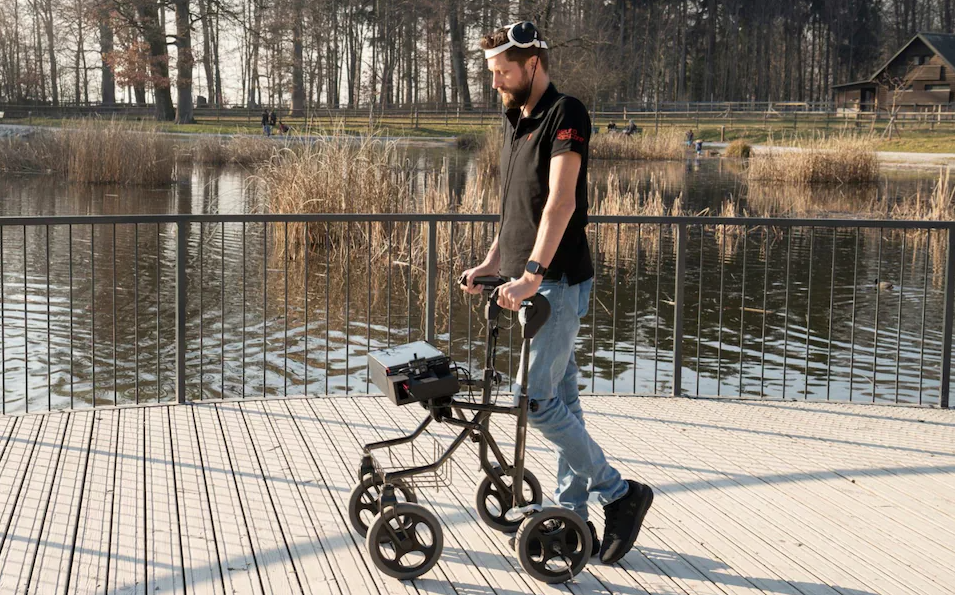
©Ecole Polytechnique Federale de Lausanne via telegraph.co.uk
Pre-reading questions:
I will read each question. Then, please answer them.
- What does it mean if a person is paralyzed?
- Do you think there’s hope for people with physical immobility? Tell me more about it.
Vocabulary:
I will read the words, meanings, and sample sentences. Then, repeat after me.
- device /dih-VAHYS/
- transmit /trans-MIT/
- command /kuh-MAND/
- adaptation /ad-uhp-TEY-shuhn/
- limitation /lim-i-TEY-shuhn/
[noun] – an object or machine that has been invented for a particular purpose
The surgeon relied on a specialized medical device to perform the delicate procedure.
[verb] – to send out or broadcast a signal
The satellite dish receives and transmits signals from space.
[noun] – an instruction to a computer to perform a particular action
He typed a series of commands into the computer terminal to execute the program.
[noun] – the process of changing to suit different conditions
The polar bear’s thick fur is an adaptation that helps it survive in freezing temperatures.
[noun] – lim-i-tey-shuhn
The physical limitations of the wheelchair user require accessible ramps and facilities.
Article reading:
Please read the whole article. Then, I will check your pronunciation and intonation.
A groundbreaking medical device has allowed a paralyzed man to regain his ability to walk naturally after more than a decade. Developed by the Swiss Federal Institute of Technology, the “brain-spine interface” connects the brain and spinal cord using implants. These implants track movement intentions in the brain and wirelessly transmit them to an external processing unit worn by the patient. The intentions are then translated into commands and sent back through a second implant to stimulate the muscles. Gert-Jan Oskam, who suffered paralysis from a motorbike accident, can now walk distances of at least 100 meters and stand unassisted for a few minutes.
What sets this device apart is that Oskam has full control over the stimulation, enabling him to initiate movement independently. By reestablishing connections between two disrupted regions of the central nervous system, the device allows for smoother movements and adaptation to different terrains. The implants have maintained a reliable connection for over a year, even during Oskam’s time at home. This successful trial opens up possibilities for treating individuals with arm and hand paralysis or those recovering from a stroke. The researchers aim to make the system more portable by reducing its size. This research marks a new era in the treatment of neurological motor limitations, offering the potential for a digital bridge between the brain and spinal cord.
What sets this device apart is that Oskam has full control over the stimulation, enabling him to initiate movement independently. By reestablishing connections between two disrupted regions of the central nervous system, the device allows for smoother movements and adaptation to different terrains. The implants have maintained a reliable connection for over a year, even during Oskam’s time at home. This successful trial opens up possibilities for treating individuals with arm and hand paralysis or those recovering from a stroke. The researchers aim to make the system more portable by reducing its size. This research marks a new era in the treatment of neurological motor limitations, offering the potential for a digital bridge between the brain and spinal cord.
Comprehension questions
I will read each question. Then, please answer them based on the article.
- Who developed the “brain-spine interface”?
- How are intentions translated into commands?
- What happens when the commands are sent back through the second implant?
- How long has the reliable connection between the implants been maintained?
- What are the potential applications of this device for treating neurological motor limitations?
Discussion questions
I will read each question. Then, please answer them.
- The article talks about the medical device that helped a paralyzed man walk again. What do you think about this incredible achievement?
- How do you feel about the potential of this device to create a connection between the brain and spinal cord?
- Do you think this device is a breakthrough for paralyzed people?
- What challenges or limitations might come with using the brain-spine interface device? How do you think researchers can overcome those challenges?
- How do you feel about the potential of this device to create a connection between the brain and spinal cord? Do you think it has the potential to change the lives of many people with similar conditions? In what ways?